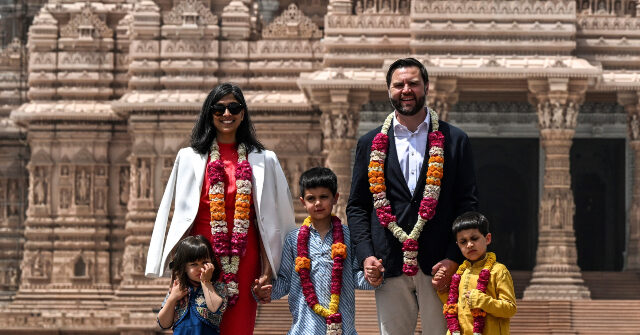Vice President JD Vance traveled to India on Monday for four days of meetings with top officials, including Prime Minister Narendra Modi.
Working out the final details of a bilateral trade agreement between India and the United States is one of the top agenda items for Vance’s trip.
Vance flew to India in the company of his wife Usha, who is the daughter of Indian immigrants and a practicing Hindu, plus their three children and several senior Pentagon and State Department officials. His first day in India is scheduled to conclude with a dinner hosted by Prime Minister Modi.
The Vances made their first stop at the Swaminarayan Akshardham Temple in New Delhi, an important house of worship, history, and Hindu scholarship.
“Thank you all so much for your hospitality and kindness in welcoming me and my family to this beautiful place. It is a great credit to India that you built a beautiful temple with precision and care. Our kids, in particular, loved it. God bless,” Vice President Vance said after his visit to the temple.
Indian newspapers and social media users were particularly interested in the Vance children wearing traditional Indian attire for their visit to the temple. Photos of the children were a trending topic on Indian social media throughout the morning.
Modi’s greeting for Vance was tinged with a bit of sadness over the unexpected passing of Pope Francis, who died on Monday after meeting with Vance in Rome on Easter Sunday. Both Vance and Modi expressed their condolences for the passing of the pontiff.
“I was happy to see him yesterday, though he was obviously very ill. But I’ll always remember him for the below homily he gave in the very early days of COVID. It was really quite beautiful. May God rest his soul,” Vance said.
“From a young age, he devoted himself towards realizing the ideals of Lord Christ. He diligently served the poor and downtrodden. For those who were suffering, he ignited a spirit of hope,” said Modi.
The Vances’ visit to India was billed as largely a personal journey with a bit of business mixed in, and perhaps a step toward laying the groundwork for President Donald Trump to visit India later this year. One of their stops will reportedly be in the city of Jaipur where they will attend a wedding.
Much attention was naturally focused upon the bilateral trade deal developing between the U.S. and India which could help reduce the tariffs President Trump announced on April 2.
India took the announcement mostly in stride, declaring its preference for an “equitable trade deal” instead of a “confrontation.” Trump put a 90-day pause on the higher tariffs for India in the hopes a trade deal could be reached.
The Indian Foreign Ministry anticipated Modi and Vance would “review the progress in bilateral relations” and “exchange views on regional and global developments of mutual interests.”
“We are very positive that the visit will give a further boost to our bilateral ties,” the Foreign Ministry said.
Both Indian and U.S. officials generally downplayed the possibility of Modi and Vance making major announcements on trade or defense after their meeting. While Indian markets would love to see some sign of optimism, India’s rivals in China predicted there would be no bilateral deal any time soon, because New Delhi and Washington have different objectives which are not easily reconciled.
China’s state-run Global Times on Sunday quoted Chinese analysts who said Modi’s “Made in India” initiative to boost his country’s manufacturing sector, a cornerstone of his administration, will not allow him to make the kind of tariff and regulatory concessions Trump wants. China has been almost hysterical in denouncing Trump’s tariffs, but India is the one major country where Beijing is happy to concede Trump has a point about foreign protectionism.
“Rather than fully aligning with U.S. interests, India would benefit more from pursuing a balanced approach, including engaging with the U.S. on its own terms while strengthening solidarity with global powers that genuinely support fair and open trade,” research director Qian Feng of Tsinghua University told the Global Times.
Qian was taking a long-shot gamble that India might be induced to forget about China’s unfair trade practices – and occasional attempts to invade Indian territory – to turn away from its most important ally and embrace its regional rival.
Indian officials said on Monday that discussions over tariffs and trade in particular industries will occur during Vance’s visit, and the talks will continue into May, giving Indian Finance Minister Nirmala Sitharaman a chance to talk with senior American officials while in Washington for a meeting of the International Monetary Fund (IMF).
Milan Vaishnav, southeast Asia program director for the Carnegie Endowment, told India’s NDTV on Monday that Vance and his family were uniquely positioned to conduct “softer diplomacy” with India, and taking that opportunity will also help Vance smooth the edges of his assertive political style.
“There is a feeling of pride in India of the Indian-American diaspora. There will be a feeling of homecoming,” Vaishnav said.
Read the full article here


